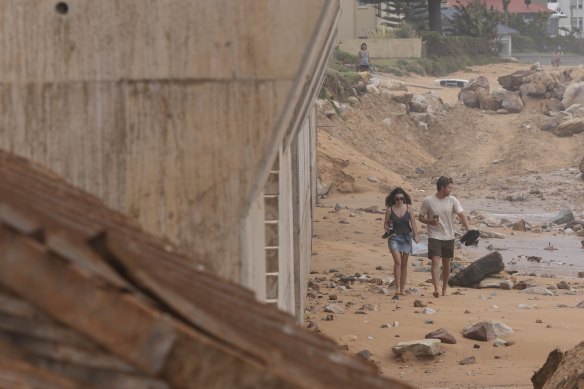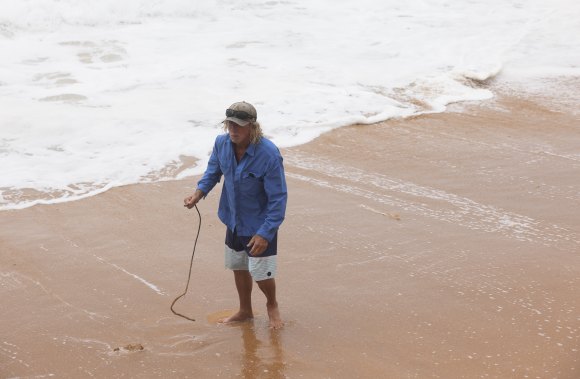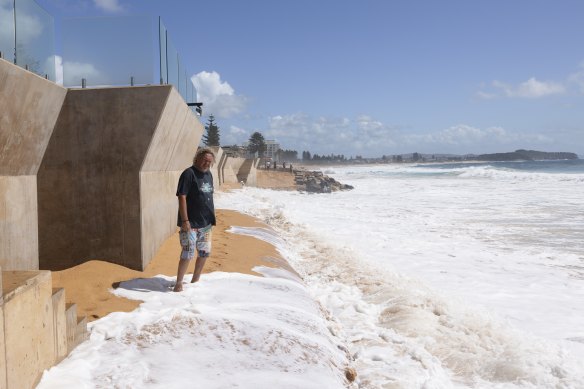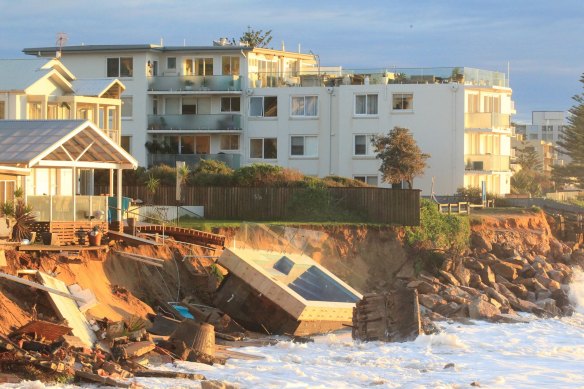This was published 3 years ago
Collaroy Beach a ‘hellscape’ as sand in front of seawall washed away: residents
By Laura Chung
Northern beaches residents have been worried about how their beloved beach would fare when large swells and high tides hit the controversial Collaroy seawall. They were concerned the sand directly in front of the seawall would be washed away, eroding their beach, and, on Tuesday, that’s exactly what happened.
The erosion event at Collaroy Beach is far from an isolated occurrence. Other beaches along the eastern coastline have also experienced heavy erosion and scientists fear climate change will only make these events more frequent and more intense.

King tides and the after-effects of ex-tropical cyclone Seth have caused erosion at Collaroy Beach.Credit: Brook Mitchell
Patrick Allan has continued an almost 100-year-old family tradition of living in Collaroy, spending years surfing the waves, but he’s planning on leaving the small seaside suburb. The building of the seawall was the final nail in the coffin.
“I’ve watched council do everything, dump truck loads of asbestos and everything here over the years, but now they’ve let this private development application come through which is going to kill this beach,” he said. “The full effects of the seawall won’t be known until they finish.”
“This is my home, but the beach and the whole area have changed.”
The coastal strip was pummelled during a massive storm in 2016. Homes were damaged and a swimming pool was pulled into the ocean, costing homeowners and local government almost $25 million to fix. Another two big storms further eroded the sand dune in July 2020.

Collaroy resident Patrick Allan has lived in the suburb his whole life but is moving away with the seawall the final nail in the coffin. Credit: Brook Mitchell
Since then, residents, council and the state government have been working to protect the properties and beach from storm surges, with current work including building a seven-metre-tall concrete wall.
Once completed, at least three-quarters of the wall will be covered by sand. The project stretches 1.3 kilometres from Collaroy to South Narrabeen, encompassing 49 private properties dotted with 11 public land areas, which include a car park and a surf club.
But not everyone is happy with the project. Earlier this year, residents lined the beach in a bid to encourage the council to invest in alternative measures to protect the beach, including a nourishment plan that would artificially replace the sand. The local community group has been protesting against a seawall for almost 30 years.
Senior lecturer at the University of NSW Water Research Laboratory Mitchell Harley said annual king tides had combined with ex-tropical cyclone Seth to create north-easterly waves that had resulted in coastal erosion along Collaroy and other beaches along the east coast.
“Collaroy normally gets waves from the south and has a big headland that protects the beach from waves, but the combination of large tides and unusually north-east waves make beaches that would normally be protected, exposed,” he said.
He said more research would be needed to determine the extent the seawall played in Tuesday’s erosion event, but that north-easterly waves were certainly a key driver in drawing sand off the beach.
University of Sydney coastal geomorphologist Professor Andrew Short said coastal erosion events were likely to become more frequent as climate change increased the likelihood of tropical cyclones and east coast lows.
“They are predicted to be more likely and more intense. It’s a double whammy,” he said.
“Most communities are built on the southern end of beaches but they will be more exposed to the impacts of erosion because of easterly storms. Governments and coastal managers need to be aware and plan for those coming changes.”

President of the northern beaches branch of the Surfrider Foundation, Brendan Donohoe, surveys the damage on Tuesday. Credit: Brook Mitchell
President of the northern beaches branch of the Surfrider Foundation, Brendan Donohoe, said Tuesday’s conditions had been treacherous to beachgoers, leaving Collaroy Beach a “hellscape”.
“It was a public beach, now it’s a public hazard,” he said. “If we get another big swell over the next few weeks, unless the council mechanically moves sand in, this beach will be impassable.”
He added that, while Tuesday’s conditions had been moderate, there were real concerns about how the coastline would fare during larger erosion events.
Mr Donohoe and other concerned residents will attend a council development application meeting opposing plans to build the next section of the seawall in the coming months.
A Northern Beaches Council spokesperson said the recent weather had caused minor erosion at Collaroy and Narrabeen, along with other locations in the area.
“This level of erosion is not uncommon during large swell and tide events of this nature and is not a direct result of the seawall under construction. The beach will recover once conditions ease,” the spokesperson said.
“The rocks exposed from the recent high tides and large swell are part of the temporary rock bund that is protecting the seawall being built during construction which will ultimately be removed once construction is complete.

The scene after the storm damaged properties at Collaroy in 2016. Credit: Peter Rae
“The bund extends approximately 10 metres seaward and has been inspected and is intact. No other construction material has been observed washing into the sea. The area will continue to be monitored for safety and access.”
The beach was closed on Wednesday due to powerful surf conditions.
The Morning Edition newsletter is our guide to the day’s most important and interesting stories, analysis and insights. Sign up here.